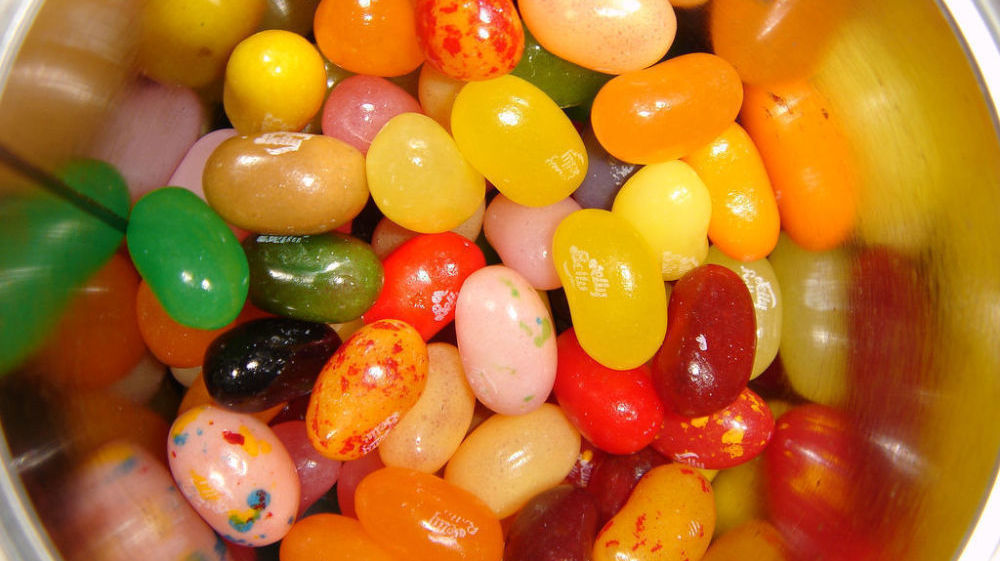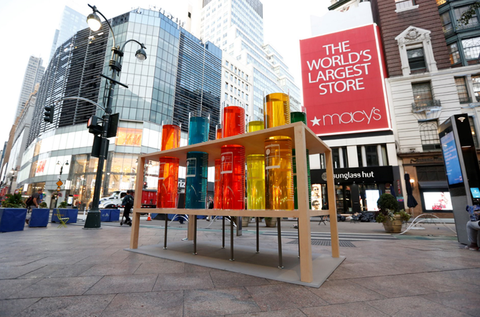Kind recently launched a visually staggering initiative to show just how much we’re consuming.
After just two years on the market, Kind has pulled its Fruit Bites from shelves. The gummy fruit snack, which contains no synthetic dyes, struggled to tempt customers, since “kids regretfully prefer to eat fruit snacks that resembled candy gems versus the dried, whole fruit that Kind uses in its products,” according to a press releasefrom the company.
“Typically, vibrant colors positively correlate to a food’s nutrition and taste quality; however, synthetic dyes counteract this thinking. The food industry uses them to their advantage to enhance visual appeal, enticing children into eating them and parents into buying them,” Stephanie Csaszar, Kind’s health and wellness expert told Bicycling.
The company wanted to use their experience to raise awareness to just how much artificial dyes we are consuming: The brand set up a display in Herald Square in New York City with giant, colorful test tubes, equaling 2,000 gallons of synthetic dyes to represent what they say is the amount of dye American children consume daily.
While the display focused on children’s diets, these same dyes are also found in many products adults eat, such as cereal, sugary drinks, yogurt, and energy gels. So should you race to your gym bag and dump out all your midrun fuel? We tapped a nutritionist to find out.
“The thing about food additives, like artificial dyes, is that the jury is still out,” Keri Gans, M.S., R.D.N., C.D.N. explains.
Here’s what you need to know.
What Are Artificial Food Dyes?
Synthetic food dyes are substances that come from a non-natural source that are used to impart color to certain foods, either to enhance natural colors or to help identify flavors—think red for cherry or purple for grape, according to the U.S. Food and Drug Administration (FDA).
The FDA requires foods that use these additives to list them on their ingredients label, so it’s easy to know if your favorite snack contains them. 
Before these color additives can be used in foods, they must be approved by the FDA for safety. The FDA considers a bunch of factors for this, such as short and longterm effects of consumption, manufacturing process, and the likely amount people would consume.
Are Artificial Food Dyes Unhealthy?
In most cases, additives and dyes in foods are considered generally recognized as safe (GRAS) by the FDA, including the Red 40, Yellow 5, and Yellow 6 that you many notice on many packaged food labels. Those that have not been deemed safe by the FDA have been eliminated from foods.
Some companies began removing these GRAS additives anyway, partly due to consumer demand, Gans explains. Plus, food dyes don’t enhance the nutritional value of foods.
So what’s the fear? People may be worried red dyes can cause cancer, because some studies linked the Red 3 to increased risk of cancer in rats; however, other studies found the correlation could not be confirmed, leaving it on the GRAS list. Typically, you’ll find Red 40—not Red 3—in most foods to give that crimson color.
Another worry is increased risk of ADHD in children, but according to the Mayo Clinic, there is no solid evidence that links the two. And, though rare, people may also be worried about having an allergic reaction to certain food dyes.
“It’s very tricky,” Gans says. “Some [worry] is backed up by science, some is not. It also comes down to personal choice and if a person is sensitive to certain ingredients.”
What Gans believes, though, is that more research needs to be done—and this includes conducting more research on the effects in humans, not animals.

Red
Should You Still Eat Foods With Artificial Dyes?
As Gans points out, it comes down to the bigger picture of overall diet. If what a person is eating is not overly processed and packaged, such as whole foods (think fruits, veggies, and nuts), there is not as much need to worry about a label.
[Build a killer midsection in the kitchen for effortless miles on the road with Eat for Abs!]
“There’s nothing wrong with occasional food with artificial color,” Gans says. “The concern is what else the diet is filled with.”
So consider whole-food snacks, such as fresh fruit or veggies dipped in hummus rather than reaching for prepackaged mac and cheese, or opting for a homemade version where time allows.
If you are crunched for time, looking at the whole label and buying one without is the next best bet, as there are many options without the dyes available for purchase. More research on the safety of these dyes is needed, according to Gans, so if you are worried, there is no harm in avoiding them in your foods. Now, it is much easier to pick out versions of your favorite product sans artificial dyes.
“It’s not just avoiding one ingredient, it’s looking at the whole label,” Gans says.
When searching for workout fuel, it’s also important to look at the whole label and find what works for you. Rather than zeroing in on one ingredient, make sure you look at the whole picture—including carbs, protein, and sugar—and know what type of fuel you need based on the intensity of the workout.
If something works well for you that may have a little artificial dye, it’s not the worst thing in the world, says Gans. Just make sure the majority of your diet is unprocessed.
She does suggest avoiding sorbitol, a sugar alcohol, because it can cause stomach distress which is the last thing you want during a workout. She suggests focusing on natural sugars instead.





Recent Comments